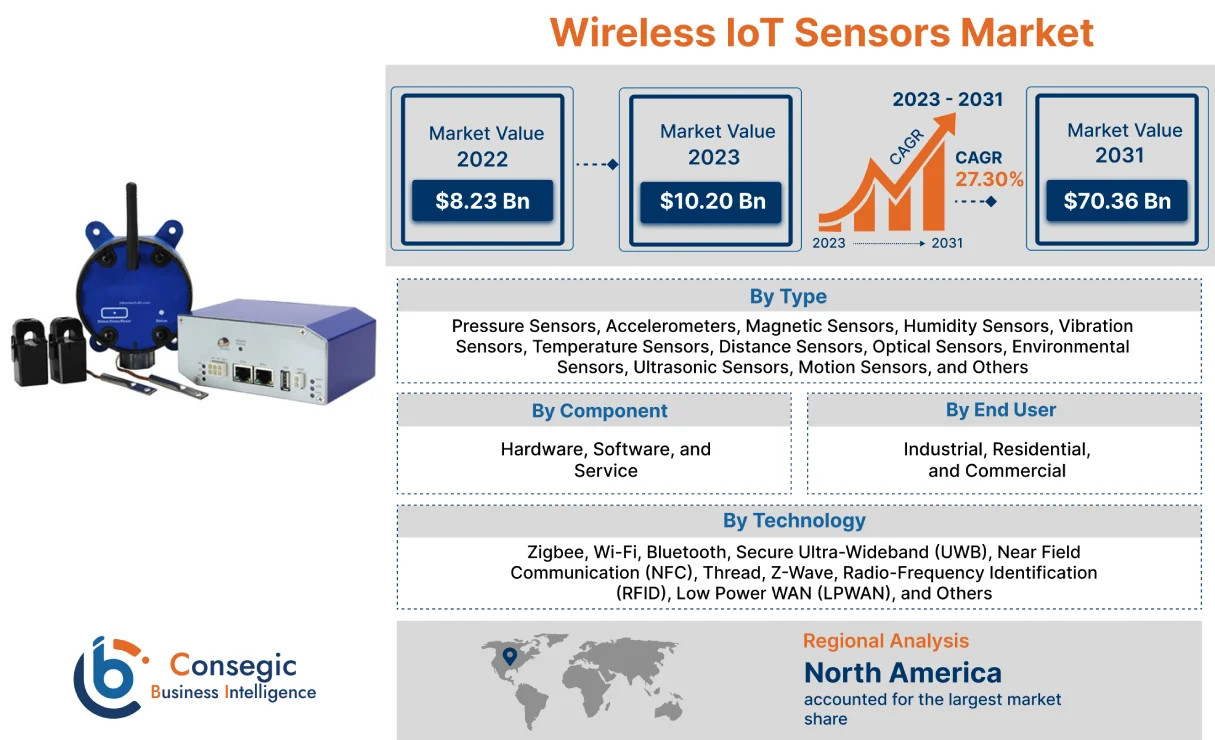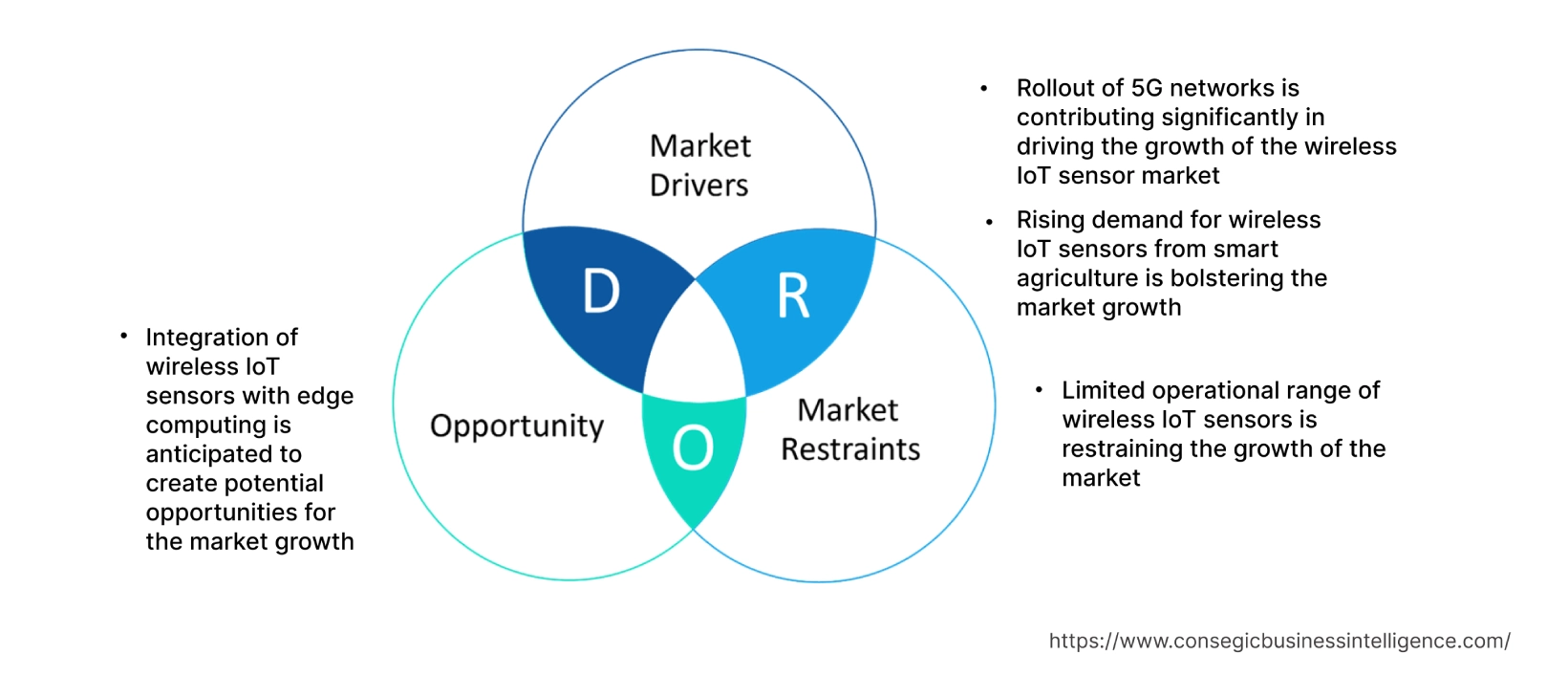Wireless IoT Sensors Market Size :
Wireless IoT Sensors Market is estimated to reach over USD 70.36 Billion by 2031 from a value of USD 8.23 Billion in 2022 and is projected to grow by USD 10.20 Billion in 2023 growing at a CAGR of 27.30% from 2023 to 2031.
Wireless IoT Sensors Market Scope & Overview:
Wireless IoT sensors are small devices equipped with wireless communication capabilities that allow the sensors to collect and transmit data from the surroundings to a central system. Additionally, the sensors monitor various environmental parameters including temperature, humidity, light, motion, and others. Furthermore, the sensors enable the creation of interconnected networks of devices to gather and analyze real-time information for automating various processes.
Wireless IoT Sensors Market Insights :
Wireless IoT Sensors Market Dynamics - (DRO) :
Key Drivers :
Rollout of 5G networks is contributing significantly in driving the growth of the wireless IoT sensor market
5G offers significantly higher data transfer speeds enabling real-time communication and data exchange, ideal for applications that require quick response times including industrial automation and autonomous vehicles. Additionally, 5G's architecture is designed to handle a massive number of devices simultaneously and also to connect and transmit data instantaneously, in smart cities and large-scale industrial deployments. Moreover, 5G provides extensive coverage over long distances, suitable for applications that require sensors to communicate across vast areas namely agricultural fields and remote monitoring sites. Furthermore, the increasing investment by the government in 5G networks to improve the digital connectivity is also contributing remarkably in bolstering the market growth. For instance, in July 2023, the government of United Kingdom invested USD 51.40 million to provide 5G benefits all across UK and also to pioneer digital connectivity for residents and business. Consequently, the expansion of the 5G infrastructure is contributing significantly in propelling the growth of wireless IoT sensors market.
Rising demand for wireless IoT sensors from smart agriculture is bolstering the market growth
Smart agriculture, also referred to as precision agriculture, leverages technology to optimize crop production, increase efficiency, and reduce resource wastage. Wireless IoT sensors play a crucial role in enabling advancements, by monitoring crop health and growth. Early detection of diseases, pests, and stress factors allows for timely interventions, reducing crop losses and the need for excessive chemical treatments. Additionally, by analyzing historical and real-time data from IoT sensors, farmers make accurate yield predictions, essential for planning harvesting, storage, and distribution activities. Moreover, wireless IoT sensors also monitor soil moisture levels and weather patterns, allowing for precise irrigation scheduling, by avoiding overwatering and reducing energy costs associated with pumping. For instance, in February 2020, Wintec Co., Ltd. launched IoT wireless smart agriculture solution for crop monitoring, yield prediction, and also to improve the fertilizer efficiency. In conclusion, the rising adoption of wireless IoT sensors in smart agriculture to improve productivity is spurring the market growth.
Key Restraints :
Limited operational range of wireless IoT sensors is restraining the growth of the market
The operational range refers to the maximum distance over which a wireless sensor communicates with a base station or gateway. The limited operational range of wireless IoT sensors leads to signal interference or degradation, resulting in unreliable data transmission and compromised accuracy. Additionally, sensors operating at the edge of the operational range, experiences higher data loss rates due to weaker signal strength, leading to reduced battery life, necessitating more frequent battery replacements. In conclusion, the limited operational range of wireless IoT sensors is impeding the growth of the global market.
Future Opportunities :
Integration of wireless IoT sensors with edge computing is anticipated to create potential opportunities for the market growth
Edge computing significantly reduces the latency associated with sending data to a distant cloud server to process crucial information for applications that require real-time responses including autonomous vehicles, industrial automation, and healthcare monitoring. Additionally, with edge computing, IoT sensors process and filter data locally before sending relevant information to the cloud. Data filtration reduces the amount of data transmitted over the network, optimizing bandwidth usage and reducing costs. Moreover, by processing data locally, edge computing alleviates network congestion, further contributing to the growth of wireless IoT sensors market. In conclusion, the integration of wireless IoT sensors with edge computing is projected to create potential opportunities for market growth during the forecast period.
Wireless IoT Sensors Market Report Insights :
| Report Attributes | Report Details |
| Study Timeline | 2017-2031 |
| Market Size in 2031 | USD 70.36 Billion |
| CAGR (2023-2031) | 27.30% |
| By Component | Hardware, Software, and Service |
| By Type | Pressure Sensors, Accelerometers, Magnetic Sensors, Humidity Sensors, Vibration Sensors, Temperature Sensors, Distance Sensors, Optical Sensors, Environmental Sensors, Ultrasonic Sensors, Motion Sensors, and Others |
| By Technology | Zigbee, Wi-Fi, Bluetooth, Secure Ultra-Wideband (UWB), Near Field Communication (NFC), Thread, Z-Wave, Radio-Frequency Identification (RFID), Low Power WAN (LPWAN), and Others |
| By End-User | Industrial, Residential, and Commercial |
| By Region | North America, Europe, Asia-Pacific, Latin America, and Middle East & Africa |
| Key Players | NXP Semiconductors, TE Connectivity, TDK Corporation, Texas Instruments Incorporated, OMRON Corporation, Analog Devices, Inc., Murata Manufacturing Co., Ltd., Fujitsu Limited |
Wireless IoT Sensors Market Segmental Analysis :
By Component :
The component segment is trifurcated into hardware, software, and service. Hardware accounted for the largest market share of 52.4% in 2022 as wireless IoT sensors rely on physical hardware components to gather data from the environment. The sensors measure parameters namely temperature, humidity, pressure, light, and motion. Additionally, the accuracy, sensitivity, and reliability of the sensors directly impact the quality of data collected, making hardware a crucial component. Moreover, several wireless IoT sensors incorporate microcontrollers or microprocessors that enable edge computing capabilities. The hardware components process and analyze data locally, reducing latency and enhancing real-time decision-making. In conclusion, the above-mentioned factors are contributing notably in boosting the growth of the hardware segment.
Services segment is predicted to witness the fastest CAGR in the wireless IoT sensors market in the upcoming years. Consulting services help tailor IoT solutions to specific needs, ensuring that wireless IoT sensors are effectively integrated into existing systems and processes. Additionally, integrating wireless IoT sensors with existing IT infrastructure, applications, and databases requires expertise. Service providers assist in seamless integration to ensure smooth data flow and interoperability. Moreover, professional deployment services ensure that sensors are placed optimally for data accuracy and reliable connectivity, leading to better outcomes and minimized operational disruptions. Furthermore, service providers remotely monitor the health and performance of deployed IoT sensors, enabling timely maintenance and troubleshooting, reducing downtime. Subsequently, the above-mentioned factors are projected to drive the growth of the services segment during the forecast period.
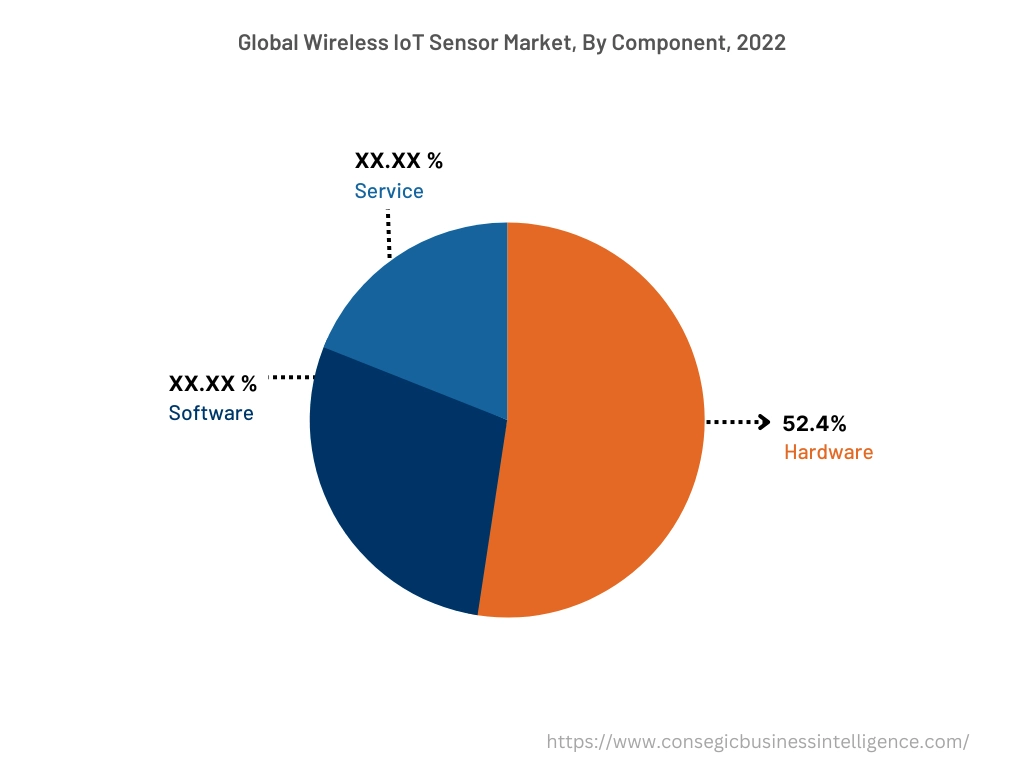
By Type :
The type segment is categorized into pressure sensors, accelerometers, magnetic sensors, humidity sensors, vibration sensors, temperature sensors, distance sensors, optical sensors, environmental sensors, ultrasonic sensors, motion sensors, and others. Temperature sensors accounted for the largest market share in 2022 as temperature monitoring is relevant across numerous sectors, including industrial processes, agriculture, environmental monitoring, HVAC systems, and others. Additionally, in industries namely food and pharmaceuticals, temperature directly impacts product quality and safety. Wireless IoT temperature sensors ensure that products are stored, transported, and processed within optimal temperature ranges. Moreover, the ability of IoT temperature sensors to operate at vast temperature ranges to monitor the energy loss from steam leaks is also contributing notably in promoting the market growth. For instance, in July 2020, Yokogawa India Ltd. launched XS550 temperature sensor with an environmentally robust design, regulated by the IEC standard, and measure both high and low temperatures. In addition, the temperature sensors monitor the temperature inside tanks and energy loss from steam leaks, thus contributing remarkably in boosting the market growth.
Pressure sensors are predicted to witness the fastest CAGR in the wireless IoT sensors market during the forecast period. The growth is attributed to the increasing adoption of pressure sensors in various automotive applications, including tire pressure monitoring systems (TPMS), engine management, and airbag deployment systems. In addition, pressure sensors are also deployed in devices namely smartphones and wearables for features including altitude measurement, GPS enhancement, and weather forecasting. Moreover, pressure sensors are also vital for aircraft systems, including cabin pressure control, engine monitoring, and flight control systems. Furthermore, pressure sensors are deployed in environmental monitoring equipment to measure atmospheric pressure changes that provide insights into weather patterns and climate changes. Consequently, the aforementioned factors are contributing significantly in fueling the growth of wireless IoT pressure sensors segment.
By Technology :
The technology segment is categorized into Zigbee, Wi-Fi, Bluetooth, Secure Ultra-Wideband (UWB), Near Field Communication (NFC), thread, Z-Wave, Radio-Frequency Identification (RFID), Low Power WAN (LPWAN), and others. Wi-Fi accounted for the largest market share in 2022 as Wi-Fi offers relatively high data transfer rates compared to some other wireless technologies. Additionally, Wi-Fi technology is suitable for applications that require the transmission of large amounts of data quickly including video streaming or high-resolution image transfers. Moreover, Wi-Fi networks cover relatively short to medium ranges, thus ideal for applications within homes, offices, factories, and other indoor environments. For instance, COMET SYSTEM, s.r.o. launched Wi-Fi temperature and relative humidity sensor for IoT applications. Furthermore, Wi-Fi sensor offers a comprehensive solution for monitoring and alarm without the need for a server solution, hence contributing notably in boosting the market growth.
Zigbee is expected to witness the fastest CAGR in the wireless IoT sensors market during the forecast period. The growth is attributed to the low power consumption of Zigbee, ideal for battery powered IoT devices, enabling sensors to operate for extended periods without frequent battery replacements and recharging. Additionally, Zigbee supports mesh networking, allowing devices to relay data between each other, extending the range and coverage of the network. Moreover, Zigbee operates on the 2.4 GHz frequency band, which avoids interference from other wireless devices using the same band, including Wi-Fi networks, thus enhancing the reliability of communication in crowded environments.
By End-User :
The end-user segment is divided into industrial, residential, and commercial. Industrial sector holds the maximum market share in 2022 as wireless IoT sensors are employed to monitor the condition of machinery and equipment in real-time. The sensors collect data on parameters namely temperature, vibration, and energy consumption, reducing downtime, preventing unexpected breakdowns, and extending the lifespan of equipment. Additionally, IoT sensors enable remote monitoring of critical industrial processes and infrastructure including environmental conditions and performance metrics remotely. Moreover, wireless IoT sensors also enable continuous asset monitoring and communicate with other systems in a cost-effective manner, further contributing to the market growth. For instance, in October 2021, Sensata Technologies introduced industrial wireless systems for IoT applications to allow constant asset monitoring of the industrial systems. In addition, the advanced wireless IoT technologies enhance the productivity and performance of assets, hence contributing notably in bolstering the market growth.
Commercial segment is anticipated to witness the fastest CAGR in the wireless IoT sensors during the forecast period. The growth of the market is endorsed by the increasing adoption of wireless IoT sensors for building automation and energy management. The sensors monitor lighting, HVAC systems, occupancy levels, and indoor air quality, enabling real-time adjustments to lighting, temperature, and ventilation to optimize energy usage and create comfortable environments. In addition, wireless IoT sensors track the location and status of valuable assets, equipment, and inventory within commercial spaces to prevent theft, streamline asset management, and reduce operational costs. Subsequently, the above-mentioned factors are contributing remarkably in bolstering the growth of wireless IoT sensors market.
By Region :
The regional segment includes North America, Europe, Asia Pacific, Middle East and Africa, and Latin America.
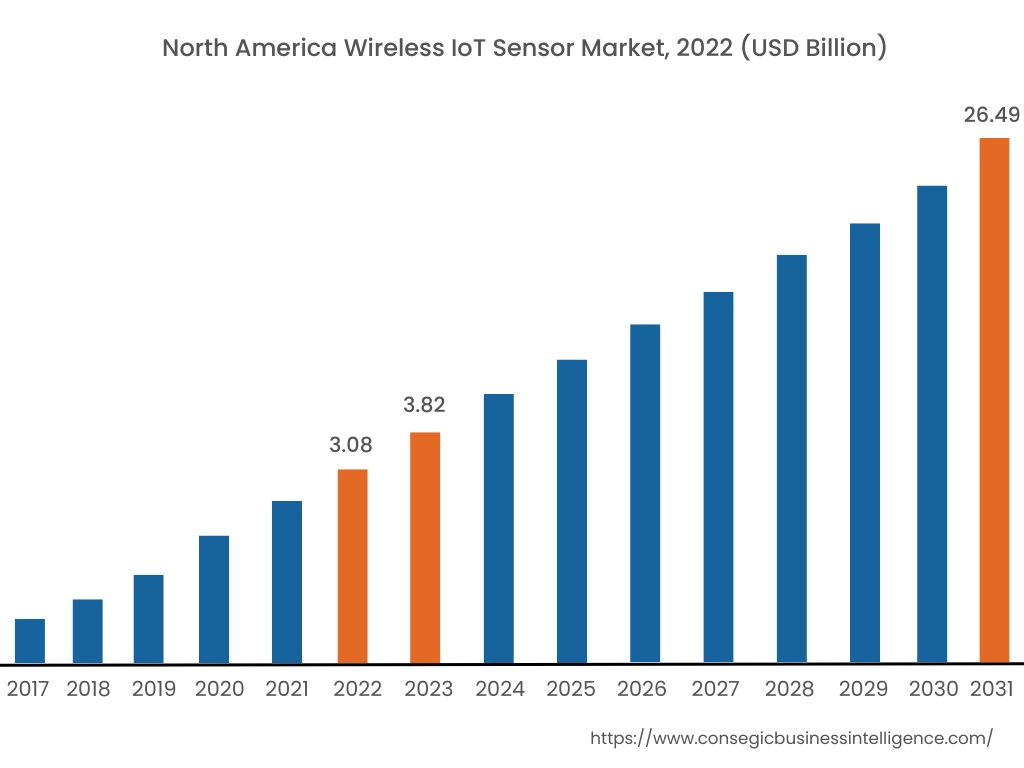
North America accounted for the largest market share of USD 3.08 Billion in 2022 and is expected to reach USD 26.49 Billion in 2031 in the wireless IoT sensors market. In addition, in the region, the U.S. accounted for the maximum revenue share of 69.35% in the year 2022. Additionally, North America encompasses leading technology companies and research institutions, which are at the forefront of technological advancements, driving innovation in IoT sensor development and applications. Moreover, the region has well-developed IT and communication infrastructure, including high-speed internet connectivity, cellular networks, and Wi-Fi coverage. The growing telecom sector provides a foundation for IoT sensor communication and data transfer, accelerating the growth of the market. Furthermore, the increasing investment by the government in the development of electronic equipment for high-speed internet networks is also fueling the market growth. For instance, in August 2023, the government of United States invested approximately USD 5 million for the development of high-speed internet networks. The high-speed internet connectivity raises the demand for wireless IoT sensors to provide real-time data, hence contributing significantly in boosting the market growth.
Asia Pacific is predicted to witness the fastest CAGR of 27.6% in the wireless IoT sensors market in the upcoming years. The growth is attributed to the expanding manufacturing sector of Asia Pacific that raises the demand of wireless IoT sensors in manufacturing processes, supply chains, and quality control. Additionally, the development of smart cities in Asia Pacific countries is also contributing notably in propelling the market growth. Wireless IoT sensors are integrated into urban infrastructure for improved traffic management, waste management, energy efficiency, and public services. In conclusion, the aforementioned factors are contributing remarkably in spurring the growth of wireless IoT sensors in Asia Pacific countries during the forecast period.
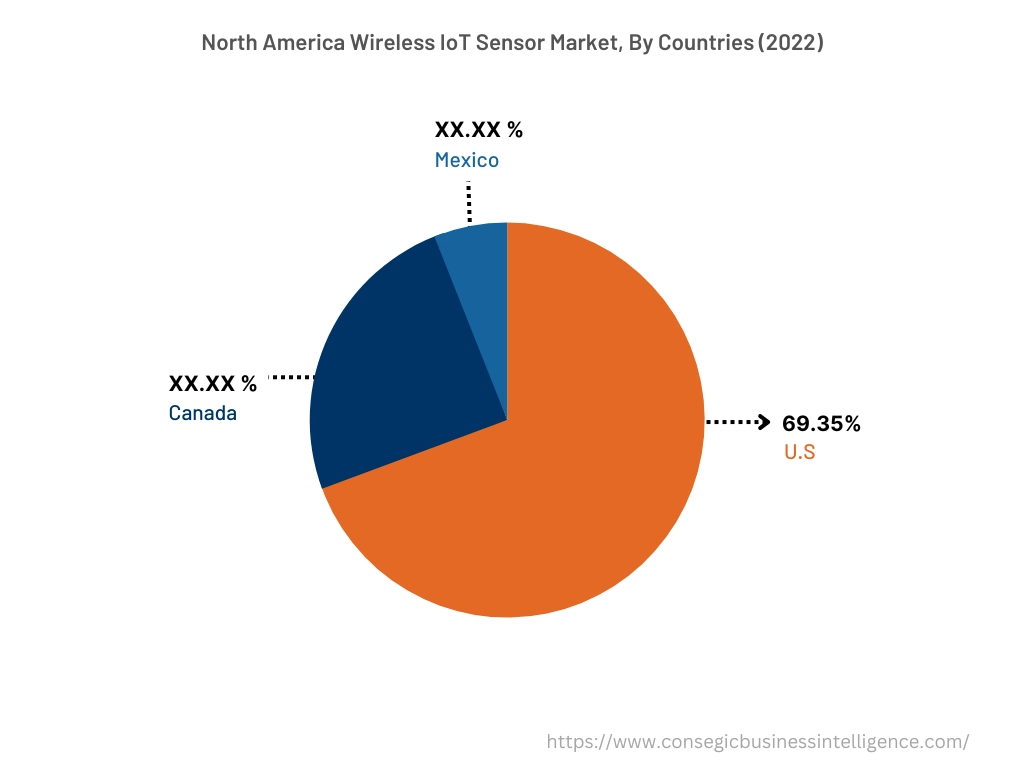
Top Key Players & Market Share Insights:
The landscape of the wireless IoT sensors market is highly competitive and has been examined in the report, along with complete profiles of the key players operating in the industry. In addition, the surge in innovations, acquisitions, mergers, and partnerships has further accelerated the growth of the wireless IoT sensors market. Major players in the market include- /div>
- NXP Semiconductors
- TE Connectivity
- Murata Manufacturing Co., Ltd.
- Fujitsu Limited
- TDK Corporation
- Texas Instruments Incorporated
- OMRON Corporation
- Analog Devices, Inc.
Recent Industry Developments :
- In August 2022, Pandora launched their new collection with lab-created diamonds and 100% recycled silver and gold.
- In December 2021, Harry Winston, Inc. announced the opening of their new retail salon in Milan, Italy.
Key Questions Answered in the Report
What are wireless IoT sensors? +
Wireless IoT sensors are small devices equipped with wireless communication capabilities that allow the sensors to collect and transmit data from the surroundings to a central system.
What specific segmentation details are covered in the wireless IoT sensors market report, and how is the dominating segment impacting the market growth? +
Temperature sensors dominates the market share in 2022 as temperature monitoring is relevant across numerous sectors, including industrial processes, agriculture, environmental monitoring, HVAC systems, and others.
What specific segmentation details are covered in the wireless IoT sensors market report, and how is the fastest segment anticipated to impact the market growth? +
Pressure sensors will witness the fastest CAGR in the wireless IoT sensors market owing to the increasing adoption of pressure sensors in various automotive applications, including tire pressure monitoring systems (TPMS), engine management, and airbag deployment systems.
Which region is anticipated to witness the highest CAGR during the forecast period, 2023-2031? +
Asia Pacific is anticipated to witness the fastest CAGR during the forecast period due to the expanding manufacturing sector and the development of smart cities.
